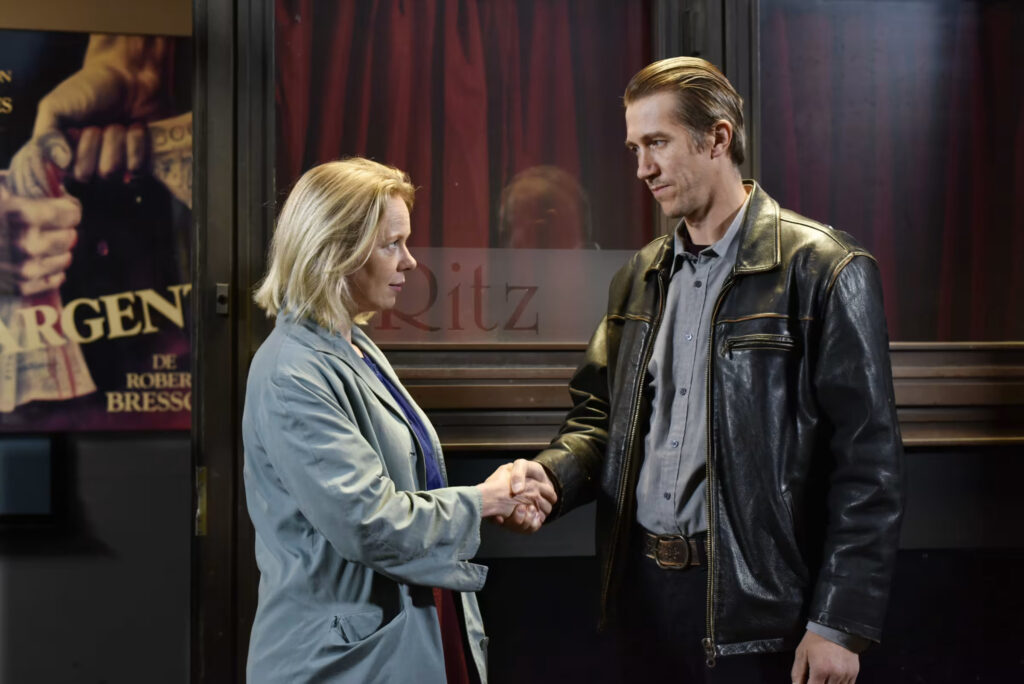
Aki Kaurismäki’s latest film, “Fallen Leaves,” is a bittersweet exploration of love amidst the harsh realities of life in Helsinki. Known for his deadpan humor and minimalist style, Kaurismäki returns with a story that is both melancholic and amusing, set in a cityscape far removed from the picturesque visions often associated with Finland. This film, described as a continuation of Kaurismäki’s ‘Proletariat Trilogy,’ captures the mundane beauty of everyday life and the struggles of the working class.
Kaurismäki presents a gritty, unvarnished view of Helsinki, filled with dusty factories, dive bars with exotic names, and old-fashioned movie theaters displaying classic film posters. The setting, combined with Kaurismäki’s signature blend of Buster Keaton-inspired comedy and classic Hollywood influences, creates a unique cinematic experience that feels timeless, even as it subtly acknowledges the present with modern touches like mobile phones and news bulletins about the war in Ukraine.
“Fallen Leaves” centers on Ansa (Alma Pöysti) and Holappa (Jussi Vatanen), two individuals leading monotonous lives. Ansa, a grocery store clerk, is fired for her kind-hearted practice of taking home expired goods and letting customers take products headed for the trash. Holappa, a factory worker, lives with his colleagues in a trailer, seeking solace in alcohol. Their paths cross at a karaoke bar, where a spark ignites between them, and a romance unfolds with a quiet, understated charm. They share simple moments like coffee dates and a viewing of Jim Jarmusch’s zombie comedy “The Dead Don’t Die”.
The relationship faces challenges, particularly Holappa’s struggle with alcoholism, which costs him his job and threatens their budding connection. Ansa’s discovery of his drinking problem forces a critical decision, raising the question of whether she can maintain her affection for him or if the relationship is doomed to falter.
Kaurismäki’s distinctive style shines through in “Fallen Leaves”; the film is characterized by its minimalist aesthetics and deadpan delivery, with cinematographer Timo Salminen capturing static shots filled with wry details and vibrant colors. The actors’ performances are deliberately restrained, almost parodic, evoking the iconic presence of Kaurismäki’s frequent collaborators like Kati Outinen and Matti Pellonpää. This approach heightens the film’s surreal, yet deeply human, atmosphere.
The director’s unique ability to blend impassive emotions with absurd, self-aware filmmaking is evident throughout the movie. From a piece of paper blowing away to the seemingly random appearance of a cute dog, these elements add a layer of humor and poignancy; Kaurismäki crafts a world governed by its own set of rules, where the mundane becomes poetic, and where even the smallest gestures carry significant emotional weight.
“Fallen Leaves” is a testament to Kaurismäki’s skill in capturing the quiet moments of life with profound empathy. The film is a delicate balance of humor and sadness, exploring themes of loneliness, resilience, and the search for meaning in an often indifferent world. Despite its bleak setting, the story is infused with hope, suggesting that love and kindness can still thrive amidst life’s difficulties.
In a cinematic landscape increasingly dominated by meaningless spectacle, “Fallen Leaves” stands out for its simplicity and authenticity. Kaurismäki’s return to filmmaking after a purported retirement offers a comforting reminder of the beauty in ordinary life and the enduring power of human connection. This film is a cherishable addition to his oeuvre, a piece that resonates with quiet beauty and understated grace.
